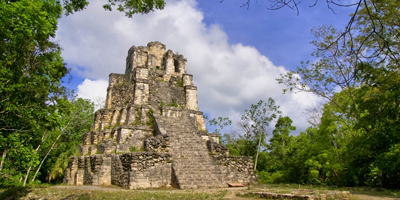Mayan Ruins Near Cancun & Riviera Maya
Mexico is rich in both architectural and archaeological history, the Yucatan Peninsula has several scenarios that demonstrate the Maya settlements and customs, this can be seen in the various communities within the state, as Ek Balamin Valladolid, Chichen Itza in Piste, as part of Uxmal Puuc Route; but also the coast has much to teach, as in the case of the Mexican Caribbean, where several Mayan constructions can be seen as Kohunlich in Chetumal to mention some.
Quintana Roo Mayan Ruins
Coba
Coba, one of the most beautiful and huge Mayan archaeological sites, is nestled in the thick jungle of the Yucatan Peninsula, surrounded by lakes and exquisite surroundings.
Kohunlich
Kohunlich ruins are loated inthekilometer 60 of the road number 186 that goes from Chetumal, in the state of Quintana Roo to Escárcega, in the state of Campeche.
El Meco Ruins
There is a Maya site north of the city of Cancun, Quintana Roo little known . This site is known as the "Meco" and is located 5 km north of Cancun, and you can access it in two ways, one is the old road to Punta Sam.
Tulum
Admire the beautiful views of the walled city by the sea, its beautiful turquoise waters, white sandy beaches, the main building of the castle, the nature of the place and all the history that this important site envolves.
Muyil
The ruins of Muyil are small with some buildings in its original state, in the middle of the jungle, is a point of interest that can be done in 1 hour or less
El Rey Ruins
The site of "The King" is required for those coming to visit Cancun, is one of the few cultural spaces available to the tourist area and is at the same time, an important refuge for many birds and reptiles found protection within the boundaries of the site.
Yucatan & Campeche Mayan Ruins
Chichen Itza
Chichen Itza, the “Mouth of the Well of the Itzaes”, is located in the eastern part of the State of Yucatan, 120 km from the City of Merida. This important center combines majesty and nature.
Ek Balam
The archaeological site of Ek Balam is located north of the city of Valladolid approximately 20 minutes by card and 40 minutes from the Chichen Itza airport. Ek Bakam in Spanish means black jaguar.
Dzibilchaltun
Dzibilchaltun means "place of writing in stone" and is the largest Mayan city discovered until, with more than 200,000 inhabitants at its peak. The city covers 16 square kilometers and has more than 8,000 structures.
Uxmal
Uxmal, “Three Times Built”, located 78 km from Merida, has a history rich in legends, myths and anecdotes. The city is located in a hilly region known as the “Puuc” region, a mayan word for “mountain range”.
Puuc Route
The Pucc route consists in the archaeological sites that are located south of the state of Yucatan, Puuc Maya means hill and is called so because all sites in this area have a similar architectural style.
Calakmul
The 27 deJunio of 2002 Calakmul was named by the General Council of UNESCO Cultural Patrimony of the Humanity. The declaration was made in Budapest, Hungary and in this event wasthe chiefof the INAH.



